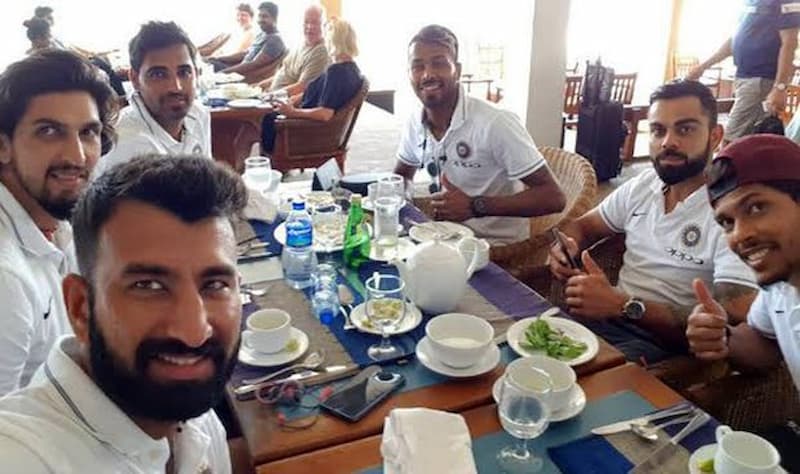Lunch/Tea Time in Test Cricket: Test cricket is the oldest and the longest format of the game, where the teams compete against each other for five days to get a result. Despite this, there are the chances that the Test match may end in a draw. The players also need to be physically and mentally fit for a five-day Test match and also need proper breaks and rest to give their best for the team.
The lunch break time in test cricket typically lasts from 40 minutes to an hour, while the tea break time is around 20 minutes. During these breaks, players leave the field to have meals and drinks, discuss tactics with teammates and coaches, and analyze the game’s progress.
In Test cricket, there are 90 overs in a day that are divided into three sessions of 30 overs each. After each session, there is a scheduled break ahead of the next session so that players remain fresh and active for the next 30 overs. It also lets players to strategize and come up with a new gameplan in the next session. The day’s play comes to an end when the final ball of the third session is bowled. The umpire signals the end of day’s play by dropping off the bails of the stumps and we call it as stumps.
Lunch Break Time in Test Cricket

A 40-minute Lunch break is scheduled after the end of the first session of the day. It is the first interval of the day and give players the much-needed downtime to recharge themselves for the upcoming session after continuous cricket for around 2-2.5 hours. The active batters and the players from the fielding usually opt to have lighter meals during the lunch break as they have to resume the play after the break. On the other hand, rest of the players can opt to go for a more substantial meal. However, the Lunch time can also be expedited or delayed if the playtime is lost due to bad weather conditions or poor light. It can be only on the agreement between the umpires and the captains of both teams.
According to law 11.5 of Marylebone Cricket Club (MCC), if an innings end 10 minutes before the pre-decided time for the lunch break, the break will be taken immediately and the rest of the time will be compensated during the innings in the next session.
The Law 11.5 states that, “If an innings ends when 10 minutes or less remains before the agreed time for lunch, the interval shall be taken immediately. It shall be of the agreed duration and shall be considered to include the 10-minute interval between innings.”
Also know: What Is Innings Break Time For ODIs, Test, T20Is, and IPL?
Tea Break Time in Test Cricket
A Tea break is a 20 minutes time between the second and third session of the day. It is an important element of the game where the get the time to regroup, strategise, rest, rehydrate and recharge themselves before the final session of the day. During the tea break, players can drink tea/coffee or any other refreshments that provide them energy to be active in the final 30 overs of the day. The third session of the day is very crucial in a Test match as both teams look to get ahead of each other before the end of day’s play to start the next day with a lead. A tea break is also an opportunity for the players to make strategies and game plan for the final session of the game.

However, the timing of the lunch and tea break can also be changed if the play time is lost due adverse weather conditions or bad lightning. The decision can be made on a mutual agreement of both the captains and on-field umpires.
The law 11.4 states, “If, at any time during the match, either Playing time is lost through adverse conditions of ground, weather or light or in exceptional circumstances, or the players have occasion to leave the field other than at a scheduled interval, the time of the lunch interval or of the tea interval may be changed if the two umpires and both captains so agree.”
However, according to the law 11.6.1, “If an innings ends when 30 minutes or less remains before the agreed time for tea, the interval shall be taken immediately. It shall be of the agreed duration and shall be considered to include the 10-minute interval between innings.”
Lunch break lets players take a much-needed rest after continuously playing for 30 overs under the sunlight since morning. Players can refresh and come up with new strategies ahead of the next session. On the other hand, players can restore their energy and recharge themselves during the 20-minute tea break before the final session of the day.
FAQs about Lunch/Tea Break Time in Test Cricket
How long is the lunch break in a Test match?
The official duration is 40 minutes. However, this can be adjusted due to weather conditions or other unforeseen circumstances.
What happens during the lunch break?
Players head back to the dressing room for their meal. Umpires and officials have refreshments. Ground staff prepare the pitch and covers for the second session. Spectators use the break for food, drinks, and bathroom visits.
Do players eat the same food during every lunch break?
No, menus vary depending on the team, location, and dietary needs. Teams often prioritize high-energy, healthy options to refuel for the next session.
Do players have access to TV or phones during the break?
This varies depending on team rules and individual preferences. Some may watch replays or tactical analysis, while others choose to relax and socialize.
Is the tea break shorter than the lunch break?
Yes, the tea break is typically 20 minutes long. It offers a shorter refreshment break without disrupting the flow of the game too much.
What happens during the tea break?
Yes, there can be drinks breaks lasting 10 minutes each, typically offered between overs in the afternoon session. These are used for hydration and quick tactical discussions.
Are there any traditions associated with lunch and tea breaks?
Some teams have specific traditions, like sharing a team meal or listening to music. Additionally, viewers often enjoy commentary and analysis during these breaks.
Why are lunch and tea breaks important in Test cricket?
They provide essential rest and refreshment for players, allowing them to perform at their best throughout the demanding five-day format. They also add a natural rhythm to the match, enhancing the spectator experience.








![Fans’ Reaction on Shivam Dube’s 2nd Consecutive Golden Duck Against Punjab Kings in Match 53 IPL 2024 [Top Memes] Shivam Dube gets out for second consecutive golden duck after being named in India's T20 World Cup squad](https://fantasykhiladi.com/wp-content/uploads/2024/05/Shivam-Dube-gets-out-for-second-consecutive-golden-duck-after-being-named-in-Indias-T20-World-Cup-squad-450x215.webp)

